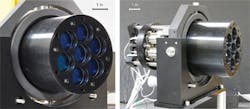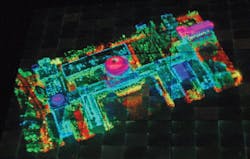PHOTONIC FRONTIERS: DARPA PROJECTS: DARPA's photonics projects - At the edge of possibility

The Defense Advanced Research Projects Agency (DARPA) was the first military agency to sponsor laser research, and it got in on the ground floor. Formed as the Advanced Research Projects Agency in 1958 in the aftermath of the Soviet Sputnik launches, DARPA was tasked to sponsor promising projects too risky for other military research agencies. Its laser opportunity came in early 1959, when Lawrence Goldmuntz and Gordon Gould, then at the now-defunct TRG Inc., pitched a proposal already turned down by the Air Force Office of Scientific Research and the Army Signal Corps. They asked for $300,000 to try to build a laser based on Gould’s laser patent application. DARPA officials loved the idea so much they raised the budget to $999,000.
The money wasn’t enough for TRG to win the laser race, but it showed DARPA could pick a good idea. Over the intervening five decades, DARPA has invested widely in cutting-edge laser and photonics research. Today, DARPA is running dozens of projects exploring the photonic frontier. This article examines three hot areas: lasers per se, beam combination and steering, and real-time 3D holographic imaging. There are many other laser, photonics, and optical projects cited on the agency’s web site, www.darpa.mil.
Lasers
Historically, DARPA’s laser projects have ranged from exploring new laser concepts to testing concepts for high-energy laser weapons. Nothing in today’s portfolio approaches the scale of the 5 MW Alpha chemical laser built in the 1980s to test the feasibility of space-based laser weapons, but the High Energy Liquid Laser Area Defense System (HELLADS) is much closer to feasibility than Alpha ever was.
The goal of HELLADS is to shrink the mass of high-energy lasers by an order of magnitude, so a 150 kW laser can be integrated into tactical aircraft. That’s the power level sought for defense against rockets, artillery, mortars, and surface-to-air missiles at distances up to a couple of kilometers. The mass target is less than five kilograms per kilowatt of output, so the whole laser would weigh less than 750 kg. Although DARPA has not identified the design, other documents say it is a diode-pumped solid-state slab laser with flowing index-matched coolant. Both the Aeronautical Systems division of General Atomics (Poway, CA; www.ga-asi.com) and Textron Defense Systems (Wilmington, MA; www.textrondefense.com) have worked on the program.
In February 2011, DARPA reported that two different designs for unit cells having integrated power and thermal-management systems had exceeded 34 kW. At the end of June, the agency reported high beam power and quality in laboratory tests of a small, lightweight laser module. “Successful testing of the single laser module is a major accomplishment,” said Richard Bagnell, DARPA’s HELLADS program manager. “Advances in diodes, cooling, lightweight electronics, pumps, optics, and metal structures have made shrinking the size and weight possible without losing laser effectiveness.”
In June, General Atomics received $40 million to continue HELLADS development. Unit cells will be replicated and assembled into a full-power 150 kW laser in the laboratory. When that laser is finished next year, it will be integrated with beam control, a power source, thermal management, and command-and-control subsystems. That system will be moved to the White Sands Missile Range in early 2013 for ground tests against rockets, mortars, and surface to air missiles.
DARPA is also hedging its bets on 150-kW-class lasers by looking at prospects for scaling an electrically excited version of the chemical oxygen-iodine laser (COIL). Oxygen-iodine lasers promise high power, but field commanders want battlefield lasers to be powered by electricity rather than special chemical fuels that could pose logistical problems. Developers of the discharge-excited COIL (DECOIL) program, powered by a microwave discharge, will first seek to reach 10% wallplug efficiency at 100 W, then try to scale the technology to demonstrate 1 kW output with wallplug efficiency of at least 10%. The next step after that would be scaling to 150 kW.
The agency also is working on nonweapon lasers. The Blue Laser for Submarine Laser Communications program seeks to demonstrate that 455 nm solid-state lasers and cesium atomic-line filters could be used for high-speed two-way communications to submarines. Attempts to develop blue-green lasers for satellite-to-submarine links go back decades, but the lasers have always proved too bulky for deployment. New blue solid-state lasers could avoid that problem and might also be used for water-penetrating lidars usable in daylight.
Some DARPA laser projects are further out. One named Ultrabeam seeks to demonstrate gamma-ray lasers with laboratory-scale equipment. Last year the agency reported a laboratory-scale x-ray laser emitting 4.5 kiloelectron photons in 30-as pulses with 10 mJ energy. The next phase seeks to boost that x-ray laser technology and use it to demonstrate coherent gamma-ray amplification in solids with high atomic numbers, for potential applications in 3D molecular imaging and debris-free advanced lithography.
Beam combination and steering
Another route to high powers is combining the beams from many limited-power lasers into a single beam with much higher power. It is most attractive for fiber and direct diode lasers, which offer higher efficiency than bulk diode-pumped solid-state lasers but are limited in output power and/or beam quality by factors such as nonlinear effects and emitting aperture size. DARPA has been exploring both beam combination and techniques for steering combined beams electronically, like phased-array radars.
The Excalibur program is aimed at developing scalable high-power phased arrays of many solid-state (particularly diode or fiber) lasers with higher efficiencies than attainable by diode-pumped bulk solid-state lasers. Potential applications include multifunction arrays, usable for target designation, laser communications, laser radar, and countermeasures, as well as 100-kW-class laser weapons.
Excalibur draws on technology developed in several earlier DARPA programs. Three projects developed crucial laser technology. Coherently Combined High-power Single-mode Emitters (COCHISE) produced high-brightness diode lasers. Those diodes could pump fiber amplifiers developed by the Revolution in Fiber Laser (RIFL) project that generate beams which can be combined coherently and spectrally. The High-Power Efficient and Reliable laser bars (HiPER) project developed kilowatt-class diode arrays, with the high spatial and temporal modulation bandwidths needed for Excalibur’s adaptive optics system.
Technology to combine beams from the fiber amplifiers comes from the earlier Adaptive Photonic Phased Locked Elements (APPLE) program. The fiber amplifiers will power arrays of emitting elements mounted on aircraft surfaces, which would combine the laser beams, steer them toward a target, and compensate for air turbulence that might otherwise disperse the power (see Fig. 1).
Goals this fiscal year include developing 3 kW combinable fiber amplifiers with electrical efficiency above 30% and beam divergence below 1.4 times the diffraction limit, and a 100 W coherent array of singlemode diodes. Next year’s goals are to boost the singlemode coherent diode array to 500 W, and demonstrate an array of seven fiber amplifiers that can deliver a 7 kW beam using coherent and spectral beam combination. In the long term, DARPA hopes to produce lasers capable of “high-power air-to-air and air-to-ground engagements … that were previously infeasible because of laser system size and weight.” That might include lasers small enough to defend unmanned aerial vehicles against next-generation shoulder-launched missiles.
A program called SWEEPER (Short-range, Wide field-of-view, Extremely agile, Electronically steered Photonic Emitter) aims to develop monolithic near-IR phased arrays to replace mechanical beam steering for lower-power lasers. The goal is “chip-scale” photonic ICs 64 elements square that can handle 10 W of power, focus it into an instantaneous field of view narrower than 0.1°, and scan across more than 45° with frame rates of 100 Hz.
Those long-term goals are ambitious. They would require increasing scanning speed a thousand-fold, reducing size by a factor of 100, achieving facet pitch of a wavelength or two, and controlling phase precisely across the whole array. For next year, DARPA seeks to demonstrate an 8 × 8 beam-forming chip, as well as beam-steering capability across a 10° × 10° area. If successful, the agency says, the technology could have dramatic impact in applications such as surveillance, 3D imaging, navigation, sensing, diagnostics, and surgery.Other DARPA photonics programs
DARPA is investigating many other photonic technologies and the list changes regularly because of the agency’s philosophy of exploring the cutting edge. Programs that don’t meet milestone goals are weeded out. Those that do meet expectations typically last only a few years, although a few larger projects such as HELLADS span longer periods.
One recent success is the Urban Photonic Sandtable Display (UPSD) program, which created a real-time, color 360° 3D holographic display to assist battle planners (see Fig. 2). The system has full parallax, 12 in. of visual depth, and accommodates up to 20 viewers without special glasses, making it much more flexible than previous 3D displays. The current version, developed by Zebra Imaging (Austin, TX) over a five-year period, can be scaled from 6 in. to 6 ft in diagonal size. DARPA has transferred the technology to the Army and Air Force for further development.
The range of projects reflects both military needs and technological opportunities. DARPA’s microsystems technology office sponsors many projects in information technology and computing, and plans a system-scale demonstration of chip-to-chip optical interconnects after this year’s demonstration of terabit transmission using 24 bidirectional channels carrying 20 Gbit/s. But it is also working on mid-ultraviolet LEDs and lasers for applications from sensing biological agents to UV sterilization of water. Don’t expect all the bright ideas to work out—they’re not supposed to. DARPA doesn’t aim for a high batting average; it’s swinging for the fences.
RESOURCES
DARPA web site; http://www.darpa.mil.
DARPA 2012 budget lists projects; http://1.usa.gov/oWxS7b.
Current DARPA projects related to lasers, optics, and photonics, selected by Laser Focus World from those listed on the agency web site in July.
Adaptive Focal Plane Array (AFPA)
Advanced Sighting System (One-Shot)
Advanced Wide FOV Architectures for Image Reconstruction and Exploitation (AWARE)
Aero-Adaptive Aero-Optic Beam Control (ABC)
Architecture for Diode High Energy Laser Systems (ADHELS)
Bioinspired Photonics (BiP)
Black Diamond
Blue Laser for Submarine Laser Communications (SLC)
Centers in Integrated Photonics Engineering Research (CIPHER)
Chip to Chip Optical Interconnects (C2OI)
Compact Mid-Ultraviolet Technology (CMUVT)
Compound Semiconductor Materials on Silicon (COSMOS)
Data in Optical Domain Network (DOD-N)
Dynamic Multi-Terabit Core Optical Networks (CORONET)
Efficient Mid-Wave Infrared Laser (EMIL)
Emissive Micro-Display (EMD)
EXCALIBUR
Gratings of Regular Arrays and Trim Exposures (GRATE)
Fiber Laser Pulse Source (FILPS)
Guided BEC Interferometry (GBECI)
Hemispherical Array Detector for Imaging (HARDI)
High Energy Liquid Laser Area Defense System (HELLADS)
High Operating Temperature Mid Wave Infrared (HOTMWIR)
Hyperspectral Radiography Sources
Information in a Photon
Low-Cost, Lightweight Portable Photovoltaics
Manufacturable Gradient Index Optics (M-GRIN)
Membrane Optical Imager for Real-Time Exploitation (MOIRE)
Multifunction Electro-Optics for Defense of US Aircraft (MEDUSA)
Nano Composite Optical Ceramics (NCOC)
Negative Index Materials (NIM)
Neovision2
Network Enabled by WDM Highly Integrated Photonics (NEW-HIP)
Optical Arbitrary Waveform Generation (OAWG)
Optical Lattice Emulator (OLE)
Optical Radiation Cooling and Heating in Integrated Devices (ORCHID)
Optical RF Communications Adjunct (ORCA)
Panoptic Analysis of Chemical Traces (PACT)
Parametric Optical Processes and Systems (POPS)
Photon Counting Arrays (PCAR)
Photonically Optimized Embedded Microprocessors (POEM)
Quantum Entanglement Science and Technology (QUEST)
Quantum Orbital Resonance Spectroscopy (QORS)
RF Photonic Technologies (RPT)
Short-Range, Wide Field-of-View Extremely agile, Electronically Steered Photonic Emitter (SWEEPER)
Surface Enhanced Raman Spectroscopy (SERS)
Slowing Storing and Processing Light (SLOW LIGHT)
Super Resolution Vision System (SRVS)
Tactical Aircraft to Increase Long Wave Infrared Nighttime Detection (TAILWIND)
Ultrabeam
Urban Photonic Sandtable Display (UPSD)
Very High Efficient Solar Cells (VHESC)
Zeno-based OptoElectronics (ZOE)
About the Author
Jeff Hecht
Contributing Editor
Jeff Hecht is a regular contributing editor to Laser Focus World and has been covering the laser industry for 35 years. A prolific book author, Jeff's published works include “Understanding Fiber Optics,” “Understanding Lasers,” “The Laser Guidebook,” and “Beam Weapons: The Next Arms Race.” He also has written books on the histories of lasers and fiber optics, including “City of Light: The Story of Fiber Optics,” and “Beam: The Race to Make the Laser.” Find out more at jeffhecht.com.

